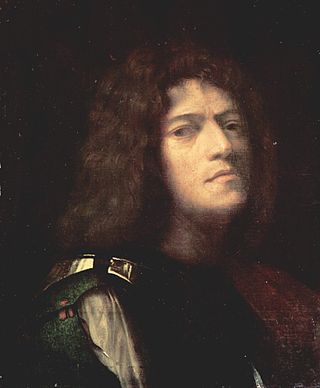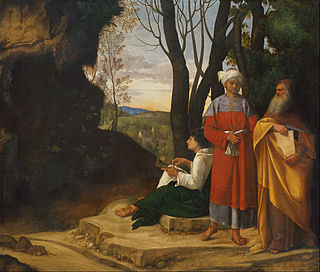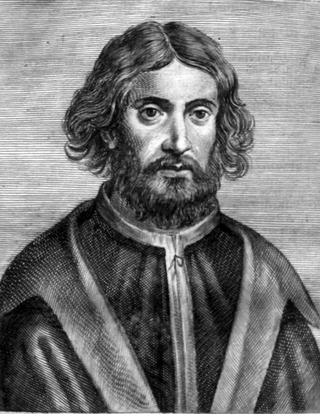
Giorgio Barbarelli da Castelfranco, known as Giorgione, was an Italian painter of the Venetian school during the High Renaissance, who died in his thirties. He is known for the elusive poetic quality of his work, though only about six surviving paintings are firmly attributed to him. The uncertainty surrounding the identity and meaning of his work has made Giorgione one of the most mysterious figures in European art.

Laura, sometimes known as Portrait of a Young Bride, is a 1506 oil on canvas painting by the Italian Renaissance master Giorgione. It is the only known painting of the author that was signed and dated by him. This work marked Giorgione's abandonment of Giovanni Bellini's models to embrace a Leonardesque style. It hangs in the Kunsthistorisches Museum in Vienna, Austria.

The Three Philosophers is an oil painting on canvas attributed to the Italian High Renaissance artist Giorgione. It shows three philosophers – one young, one middle-aged, and one old.

Palma Vecchio, born Jacopo Palma, also known as Jacopo Negretti, was a Venetian painter of the Italian High Renaissance. He is called Palma Vecchio in English and Palma il Vecchio in Italian to distinguish him from Palma il Giovane, his great-nephew, who was also a painter.

Venetian painting was a major force in Italian Renaissance painting and beyond. Beginning with the work of Giovanni Bellini and his brother Gentile Bellini and their workshops, the major artists of the Venetian school included Giorgione, Titian, Tintoretto (1518–1594), Paolo Veronese (1528–1588) and Jacopo Bassano (1510–1592) and his sons. Considered to give primacy to colour over line, the tradition of the Venetian school contrasted with the Mannerism prevalent in the rest of Italy. The Venetian style exerted great influence upon the subsequent development of Western painting.

The Venetian painter Titian and his workshop made at least six versions of the same composition showing Danaë, painted between about 1544 and the 1560s. The scene is based on the mythological princess Danaë, as – very briefly – recounted by the Roman poet Ovid, and at greater length by Boccaccio. She was isolated in a bronze tower following a prophecy that her firstborn would eventually kill her father. Although aware of the consequences, Danaë was seduced and became pregnant by Zeus, who, inflamed by lust, descended from Mount Olympus to seduce her in the form of a shower of gold.

Lucretia and her Husband Lucius Tarquinius Collatinus or Tarquin and Lucretia is an oil painting attributed to Titian, dated to around 1515 and now in the Kunsthistorisches Museum in Vienna. The attribution to this artist is traditional but uncertain - the brightened palette suggests it could instead be by Palma Vecchio. However, others identify the painting as part of Titian's series of half-length female figures from 1514 to 1515, which also includes the Flora at the Uffizi, the Woman with a Mirror at the Louvre, the Violante and the Young woman in a black dress in Vienna, Vanity in Munich and the Salome at the Galleria Doria Pamphilj. There is an early copy in the Royal Collection.

Tarquin and Lucretia is an oil painting by Titian completed in 1571, when the artist was in his eighties, for Philip II of Spain. It is signed, and considered to have been finished entirely by Titian himself. It is one of a series of great works from Titian's last years, but unlike some of these, is fully finished. It is now in the Fitzwilliam Museum in Cambridge, England.

A Man with a Quilted Sleeve is a painting of about 1510 by the Venetian painter Titian in the National Gallery, London, measuring 81.2 by 66.3 centimetres. Though the quality of the painting has always been praised, there has been much discussion as to the identity of the sitter. It was long thought to be a portrait of Ariosto, then a self-portrait, but since 2017 has been called Portrait of Gerolamo (?) Barbarigo by the gallery, having also been called merely Portrait of a Man, the title used here, The Man with the Blue Sleeve, and no doubt other variants.

Violante is an oil on panel painting attributed to Titian, dated to c. 1515. It is held at the Kunsthistorisches Museum, in Vienna.

Flora is an oil painting by Italian late Renaissance painter Titian, dated to around 1515 and now held at the Uffizi Gallery in Florence.

Salome, or possibly Judith with the Head of Holofernes, is an oil painting which is an early work by the Venetian painter of the late Renaissance, Titian. It is usually thought to represent Salome with the head of John the Baptist. It is usually dated to around 1515 and is now in the Doria Pamphilj Gallery in Rome. Like other paintings of this subject, it has sometimes been considered to represent Judith with the head of Holofernes, the other biblical incident found in art showing a female and a severed male head. Historically, the main figure has also been called Herodias, the mother of Salome.

The Gypsy Madonna is a panel painting of the Madonna and Child in oils of about 1510–11, by Titian, now in the Kunsthistorisches Museum in Vienna. It is a painting made for display in a home rather than a church.

The Madonna of the Cherries is a 1515 painting by Titian, heavily influenced by the work of Giovanni Bellini. Originally oil on wood, it was later transferred to canvas. During the 17th century it formed part of the collection of Archduke Leopold Wilhelm, where it was copied by David Teniers. It is now in the Kunsthistorisches Museum in Vienna.

Theatrum Pictorium, or Theatre of Painting, is a short-hand name of a book published in the 1660s by David Teniers the Younger for his employer, the Archduke Leopold Wilhelm of Austria. It catalogs 243 Italian paintings in the Archduke's collection of over 1300 paintings. The paintings are reproduced by engravings made by various engravers after reduced-size copies (modelli) created by Teniers. David Teniers' brother Abraham Teniers was involved in organizing the publication of the work. A second edition with page numbers was published in 1673.

Saint Margaret and the Dragon is the title shared by two paintings of Saint Margaret by the Renaissance painter Raphael, both executed in about 1518. One is held in the Kunsthistorisches Museum in Vienna, the other in the Louvre in Paris.

Archduke Leopold Wilhelm and the artist in the archducal picture gallery in Brussels is a 1651 painting of Archduke Leopold Wilhelm's Italian art collection by the Flemish Baroque painter David Teniers the Younger, now held in the Kunsthistorisches Museum in Vienna.

Bartolomeo della Nave was a Venetian merchant and art collector.

Nymph and Shepherd, also called Shepherd and Nymph, is an oil painting by the Venetian master Titian, made about 1570. The painting is in the collection of the Kunsthistorisches Museum in Vienna.

Christ and the Adulteress, also titled Christ and the Woman Taken in Adultery, or The Adulteress before Christ, is an oil painting by Titian, made about 1520, in the Kunsthistorisches Museum, Vienna, depicting Jesus and the woman taken in adultery.






















